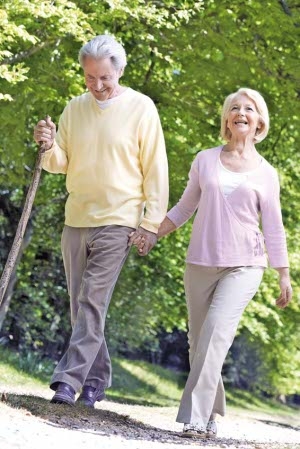Walking is easy to do and offers many benefts.
What’s not to like about walking? It’s free. It’s easy to do, and it’s easy on the joints. And there’s no question that walking is good for you. Walking is an aerobic exercise; a University of Tennessee study found that women who walked had less body fat than those who didn’t walk. It also lowers the risk of blood clots, since the calf acts as a venous pump, contracting and pumping blood from the feet and legs back to the heart, reducing the load on the heart. Walking is good for you in other ways as well.
Walking improves circulation.
It also wards off heart disease, brings up the heart rate, lowers blood pressure and strengthens the heart. Studies at the University of Colorado at Boulder and the University of Tennessee found that post-menopausal women who walked just one to two miles a day lowered blood pressure by nearly 11 points in 24 weeks. Women who walked 30 minutes a day reduced their risk of stroke by 20 percent – by 40 percent when they stepped up the pace, according to researchers at the Harvard School of Public Health in Boston.
Walking lowers the risk of fractures.
A Brigham and Women’s Hospital, Boston, study of post-menopausal women found that 30 minutes of walking each day reduced their risk of hip fractures by 40 percent.
Walking as exercise can lead to a longer life.
Recent research out of the University of Michigan Medical School and the Veterans Administration Ann Arbor Healthcare System says those who exercise regularly in their fifties and sixties are 35 percent less likely to die over the next eight years than their non-walking counterparts. That number shoots up to 45 percent less likely for those who have underlying health conditions.
Walking supports joints.
It tones muscles that, in turn, support the joints, especially the leg and abdominal muscles – and even arm muscles if you pump them as you walk. Walking can also stop the loss of bone mass for those with osteoporosis, according to Michael A. Schwartz, MD, of Plancher Orthopedics & Sports Medicine in New York. “One of the well-known orthopaedic phrases is ‘Life is lotion and lotion is life.’ Walking starts that ‘lotion’ moving through the joints,” explains Dr. Schwartz.
The majority of joint cartilage has no direct blood supply.
It gets its nutrition from synovial or joint fluid that circulates as we move. Impact that comes from movement or compression, such as walking, “squishes” the cartilage, bringing oxygen and nutrients into the area. If you don’t walk, joints are deprived of life-giving fluid, which can speed deterioration. What’s more, muscles surrounding the fragile joints atrophy, additionally stressing them and making them unstable and prone to injury.
Walking increases the strength and flexibility of your muscles, increasing the range of motion and shifting the pressure and your weight from joints to muscles – which are meant to handle weight – helping to lessen arthritis pain. Extra body weight also adds pressure to joints. With a walking program, you’re not only strengthening the muscles to better carry additional weight, you’re trimming away unwanted pounds and eliminating pressure – a two-for-one benefit.
Source: arthritistoday.org







